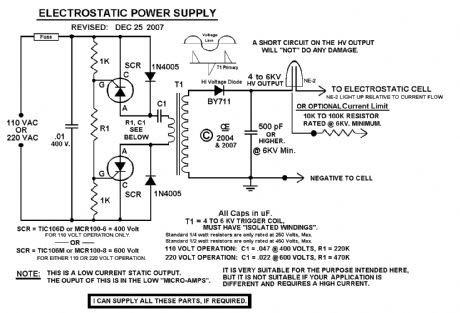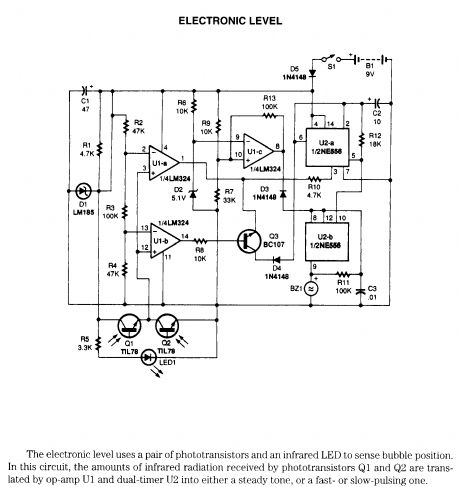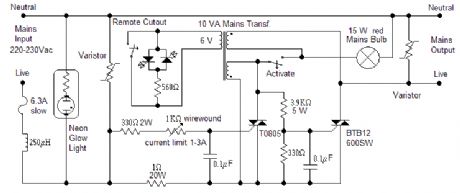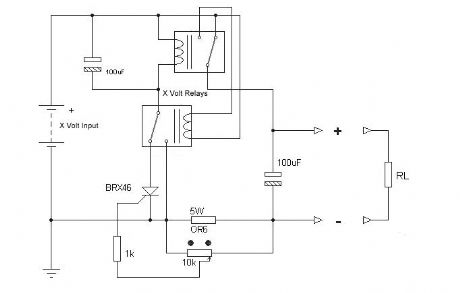
Basic Circuit
Index 42
Electro-Static Air Filters
Published:2013/5/7 21:46:00 Author:muriel | Keyword: Electro-Static Air Filters
View full Circuit Diagram | Comments | Reading(1855)
Electronic level
Published:2013/5/7 21:45:00 Author:muriel | Keyword: Electronic level
View full Circuit Diagram | Comments | Reading(0)
5W INVERTER
Published:2013/5/7 21:40:00 Author:muriel | Keyword: 5W INVERTER
View full Circuit Diagram | Comments | Reading(534)
SCR INVERTER
Published:2013/5/7 21:38:00 Author:muriel | Keyword: SCR INVERTER
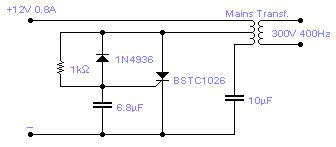
The only drawback with this circuit is that it might latch in the conducting state if the load is too heavy or if there is a short at the output, this requires some kind of protection, on the input line, in the form of a fuse or similar. The transformer used is a 10W mains type with 6V+6V windings on the SCR side and a 110V+110V windings, in series, at the output. Efficiency is 50% and the ideal load is equivalent to a 22k resistor, 5W. The output waveform is vaguely sinusoidal at a frequency of 400Hz. (View)
View full Circuit Diagram | Comments | Reading(1715)
ZENER OSCILLATORS
Published:2013/5/7 21:36:00 Author:muriel | Keyword: ZENER OSCILLATORS
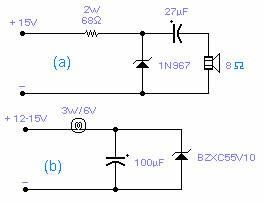
These two circuits are interesting from an academic point of view. Their practical implementation is rather critical and it is not easy to get steady operation. Circuit (a) requires a cooked zener: connect it first to a constant current generator, then increase the current until the voltage across the zener starts to decrease. Reduce the supply current and wait a few minutes until it really warms up. The zener is now ready for the circuit: increase the voltage slowly until it oscillates (1KHz in the circuit shown). You may need to decrease the voltage once oscillation takes place. With suitable circuit components it will oscillate up to 20MHz. Circuit (b) will oscillate at a very low frequency, normally 2-5Hz, provided the voltage is increased very slowly, loading is critical and you may find that a slightly different lamp will work better. Higher voltage zeners work better than low voltage zeners and the circuits operate only with the specified types. The reasons for the oscillations are unknown, although, for circuit (b) it is felt that some kind of reversible thermal breakdown is at work. (View)
View full Circuit Diagram | Comments | Reading(635)
SCR OSCILLATOR
Published:2013/5/7 21:35:00 Author:muriel | Keyword: SCR OSCILLATOR
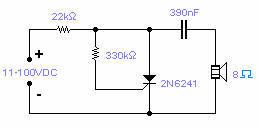
Silicon controlled rectifiers (SCR) can easily oscillate if there is an inductor (a speaker coil in this case) which gives just enough extra voltage to completely switch off the sustain current. In this way a new cycle may start and oscillations set in. It operates over a wide range of supply voltage and components values are not critical at all. Operational frequency in this circuit goes from 100Hz at 11V to 10KHz at 100V (View)
View full Circuit Diagram | Comments | Reading(990)
ELECTRONIC ATTENUATOR
Published:2013/5/7 21:30:00 Author:muriel | Keyword: ELECTRONIC ATTENUATOR
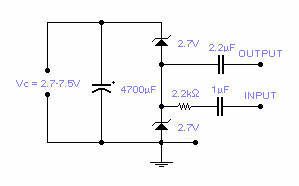
Two low voltage, low power zeners are used to control electronically the level of an audio signal. The attenuation range is from 6 to 58dB for an input current from 0.042 to 77mA corresponding to a control voltage from 2.7 to 7.5V. If control voltage is limited to 5V, the attenuation is around 30dB at a control current of 2mA. This is not an HiFi attenuator but might come useful as a general purpose audio attenuator. (View)
View full Circuit Diagram | Comments | Reading(637)
REVERSE BIAS OSCILLATOR
Published:2013/5/7 21:29:00 Author:muriel | Keyword: REVERSE BIAS OSCILLATOR
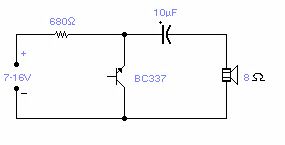
There are a number of npn transistors that will oscillate in the audio range when reverse biased. Minimum supply voltage is 7V for low power transistors such as BC109, BC238 and 2N2222A (about 10V for the latter), it becomes 12V for medium power transistors such as BD139 and is 16V for power transistors as BUX22 and 2N6543. Current drain is 4mA at 9V and frequency of oscillation is 550Hz. The base is normally left open. (View)
View full Circuit Diagram | Comments | Reading(527)
SIMPLE WARNING SIGNAL
Published:2013/5/7 21:25:00 Author:muriel | Keyword: SIMPLE WARNING SIGNAL

This power audio oscillator could be used as a warning signal for alarm systems or to attract attention if something is wrong with an equipment. The oscillator, about 750Hz, exploits the characteristic of certain NPN transistors, in this case a BC337, to oscillate if reverse biased and with the base open. Other equivalent transistors might not work. Despite its simplicity the circuit is quite flexible: the 390Ω resistor, normally connected to negative could be switched in through a logic circuit, so it can be driven directly by the circuit to be monitored; the base is normally not used but frequency modulation of the circuit is possible by connecting a modulating signal to the base via a high value resistor, typically 2.2MΩ.
A 3W loudspeaker is adequate for the circuit and it can be either an 8 or 4Ω loudspeaker, although in the latter case a small heatsink is necessary for the BD436. Peak current for an 8Ω loudspeaker can be as high as 1.2A but because the duty cycle is relatively small, the average current was measured at 0.2A hence the overall power requirement is only 2.4W despite the high volume the circuit is capable of. The feed line must be well filtered and can be anything between 9 and 15V although adjustment of the resistor might be required as the oscillation frequency is sensitive to the supply voltage. (View)
View full Circuit Diagram | Comments | Reading(703)
POINT-CONTACT OSCILLATORS
Published:2013/5/7 21:24:00 Author:muriel | Keyword: POINT-CONTACT OSCILLATORS
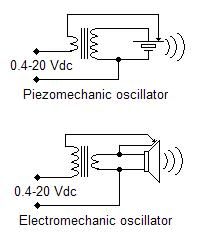
The principle of operation of a car hooter has been applied to both a ceramic sounder and a loudspeaker. A break in the supply current is caused by the vibration of the ceramic sounder plate or the speaker membrane. You could implement similar circuits even without a transformer but the voltage range will be limited, there will be too much sparking at the contact point and pressure and position of the contact become critical. The transformer introduces a feedback mechanism thus eliminating or drastically reducing all mentioned negative effects. An output transformer is used in both circuits: one of the winding is normally 4 or 8Ω while the other is at a higher impedance. The larger plate of the piezomechanic oscillator goes to positive through the contact, typically an adjustable screw, and the transformer low impedance winding. To get the correct phase relationship you may need to reverse one of the windings. A similar transformer is used for the electromechanic oscillator with the low impedance winding connected to the speaker. Also in this case you may need to reverse one of the windings but first you must make sure that the speaker cone goes forward when the voltage is applied: reverse the speaker connections if necessary. A small copper strip is glued on the back of the speaker membrane with a screw placed in the speaker casing so that it just touches the copper strip.
Frequency of operation is from 1 to 1.5 KHz for both oscillators. The frequency for the electromechanic oscillator depends mainly on the speaker damping factor: best results are obtained with the speaker laid against a flat surface or sealing the front side with a wooden panel. Operation below 0.4-0.6V depends on the careful adjustment of the screw and mechanical precision of the assembly. (View)
View full Circuit Diagram | Comments | Reading(823)
PIEZOELECTRIC TRANSFORMER
Published:2013/5/7 21:23:00 Author:muriel | Keyword: PIEZOELECTRIC TRANSFORMER
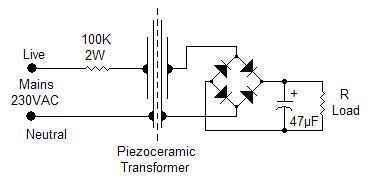
If there is a need to feed very low power devices you may resort to infrared optocouplers, solar cells, batteries or low power transformers although the latter might be rather oversized for the intended purpose. Eventually, with the exception of solar cells, all of them draw power from the mains so it might be convenient to use a piezoelectric transformer if the power required is in the range 0.1 to 0.3 mW. The schematic shows an easy implementation of such a transformer. Two piezoceramic sounders are glued back-to-back so that the mechanical movement of the first, the primary, is transferred to the second, the secondary. The ac output voltage can be used as it is or rectified in order to feed micropower electronic equipment or trickle charge small backup batteries. The actual implementation requires two ceramic sounders with high intrinsic capacitance: sounders with 80 to 110nF are readily available and usually come as 50mm discs. Two of these discs are cut down to 35mm in order to have a more compact unit and a lower stray capacitance between primary and secondary. A layer of double-sided adhesive tape is laid on the larger plate of each sounder in order to assure proper electrical insulation between primary and secondary. The sides of the sounders are then pressed against each other and the transformer is ready to operate.
R Load
VAC
VDC
100 KΩ
5.1
4.67
47 KΩ
4.22
3.29
22 KΩ
2.77
2.06
10 KΩ
1.41
1.1
4.7 KΩ
0.68
0.56
The table shows the measured output under several loading conditions: the ac output was measured with the load directly across the output terminals while the dc output was measured with a full wave rectifier in place. The measured dc voltage refers to a schottky bridge rectifier but the use of standard 1N4004 diodes will only show a modest 6-8% voltage decrease. Measurements were taken with the transformer operating in free air, without any holder, but a proper mechanical layout would require the transformer to be firmly held by the edge of the disc. The use of a plastic box is mandatory for safety reason and improves the transfer of mechanical energy to the secondary thus obtaining a 15-20% voltage increase. (View)
View full Circuit Diagram | Comments | Reading(1308)
ELECTRONIC FUSE 3
Published:2013/5/7 21:22:00 Author:muriel | Keyword: ELECTRONIC FUSE
View full Circuit Diagram | Comments | Reading(589)
5W INVERTER
Published:2013/5/7 21:21:00 Author:muriel | Keyword: 5W INVERTER

A single transistor is all you need for this simple inverter. The main aim of this circuit is to provide a suitable supply for all kind of low power battery chargers that normally connect to the mains such as mobile phones, electric shavers, etc, even an electronic neon light rated at 5W was successfully connected. Only easily obtainable components are used. The transformer is a standard 10VA mains transformer with two 6V windings connected as shown in the schematic. Frequency of operation is between 70 and 190Hz depending on the nature of the load. This frequency is acceptable by most devices but obviously it is not suitable to drive frequency dependent appliances such as clocks or small motors that depend on the mains frequency in order to operate reliably. The transistor will not require any additional heatsink if it is assembled on the metallic case provided for the inverter. The neon glow light will give a useful indication, and warning, on the presence of a dangerous voltage at the output. A 2.5A fuse on the input supply line would be a useful addition. Operation is simple: switch on the unit and connect the load keeping an eye on the neon glow light which should be always on: certain switching chargers demand an initial peak current effectively shorting the output and switching off the neon: in this case you have to try repeatedly to connect the load until it works. A temporary short at the output and a temporary voltage reversal at the input will not damage the unit. Efficiency was not a design parameter however it was measured to be between 50 and 60%. If you have a 110V mains transformer and consequently a 110VAC output you should change the 0.1μF capacitor to 0.22μF, 400V. The waveform is only vaguely sinusoidal. Invert the connection of one of the 6V windings if oscillations do not set in. (View)
View full Circuit Diagram | Comments | Reading(715)
MINIMAL AUDIO OSCILLATORS
Published:2013/5/7 21:20:00 Author:muriel | Keyword: MINIMAL AUDIO OSCILLATORS
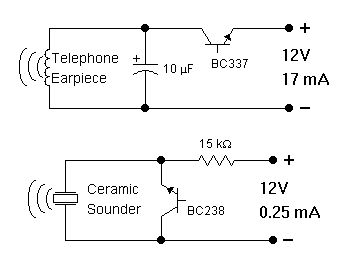
In order to generate a single note you may try these simple circuits. With only three components you may implement some basic buzzers. You need a telephone earpiece for the first circuit. Any old telephone set has got one of those magnetic earpiece that is right for our purposes. Add an extra capacitor and a transistor and you have your buzzer. Frequency of operation is about 1800 Hz and the capacitor must be changed if you wish to have a different frequency. The second circuit is implemented with a ceramic sounder: its intrinsic capacity is used to make another simple buzzer. Working frequency is 800 Hz and power drain is really low. The operating voltage is 9,5 - 20V for the circuit with the ceramic sounder and 8 - 16V for the other circuit. Do not expect a loud sound level: it is rather limited just as the current drain is. These buzzers are suitable for audio signaling on portable devices and wherever it is necessary to have a sound source implemented with a minimum components count. Not all transistors will oscillate: you have to use the specified type although I found that the BC109 and 2N2222A will also work albeit at a slightly different voltage. (View)
View full Circuit Diagram | Comments | Reading(652)
ELECTRONIC RELAY
Published:2013/5/7 21:19:00 Author:muriel | Keyword: ELECTRONIC RELAY
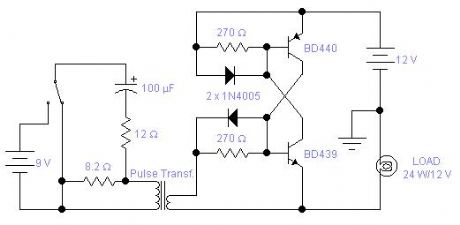
In some applications where you require speed of operation and no contact bouncing, you may find this circuit helpful. This is really the implementation of an SCR with discrete components. The medium power complementary pair will switch on and off a load up to 3A. You may modify the circuit to carry up to 10A using suitable power transistors and diodes. The left side of the circuit shows a typical drive. This electronic relay will latch in the on or off position depending on the direction of the pulse going through the primary winding of the transformer. You may omit the capacitor altogether; in this case the circuit behaves very much like the coil of a relay: when you apply a voltage to the primary it will switch on and when you remove the voltage it will switch off. The drawback in this second case is that there is a large amount of power dissipated in the 12Ω resistor which must be rated accordingly. The pulse transformer is recovered from a faulty electronic neon light. The drive circuit for these lamps always includes a pulse transformer. The higher impedance, or resistance, is the primary and the other winding is the secondary. The measured resistance was below 0.4Ω and the inductance was 680 and 47μH for the primary and secondary respectively. The ideal would be a pulse transformer with two secondary windings so that both transistors could be driven but you have the same results if the drive is applied to one transistor only. The circuit has its limitations: there is a voltage drop across the switch, in the on state, between 0.7 and 1V, this may not be acceptable in low voltage applications; it will work only with DC supplies and there is a minimum sustain current, 12mA in the circuit shown. Below this current the switch will revert to its off state. You may, of course, design a circuit with low power transistors with a sustain current of only a few μA if necessary. (View)
View full Circuit Diagram | Comments | Reading(655)
BASIC INFRARED TX-RX
Published:2013/5/7 21:14:00 Author:muriel | Keyword: BASIC INFRARED TX-RX

The transmitting section of this infrared tx-rx is unusually simple but it works rather well: the infrared LED pulses at a frequency of 160Hz and its range, with its receiver, is between 2 and 4m depending on the transformer used and the setting of the 100k pot. With other receivers it may reach a range of 15m, without any lens but with a perfect alignment between tx and rx. The receiving section uses an infrared phototransistor and an additional infrared emitter is placed next to it in order to provide a light bias thus improving sensitivity. The 100k pot. will also adjust sensitivity by setting the right operating point for the transistor. The supply should be well regulated in order to avoid self-oscillations. The audio transformer is a small output transformer recovered from an old transistor radio. (View)
View full Circuit Diagram | Comments | Reading(1486)
ZERO CROSSING AC SWITCH OSCILLATOR
Published:2013/5/7 21:13:00 Author:muriel | Keyword: ZERO CROSSING AC SWITCH OSCILLATOR
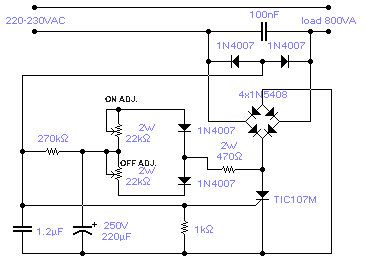
The circuit shown will switch on and off a resistive or inductive load up to 800VA with the possibility to adjust both the on and off period. Switching takes place during the zero crossing of the sine wave. The switch on point is around the zero crossing but pinpoint accuracy is not guaranteed due to the analogue nature of the circuit. The on period is adjustable between 0.3 to 4sec while the off period is adjustable between 0.2 and 10sec. The chosen SCR has a sensitive gate: this avoids the use of a large electrolytic capacitor. Frequency of operation is fairly stable although it is slightly affected by temperature, supply voltage and loading conditions. (View)
View full Circuit Diagram | Comments | Reading(762)
WINDSCREEN LOOP AERIAL
Published:2013/5/7 21:12:00 Author:muriel | Keyword: WINDSCREEN LOOP AERIAL
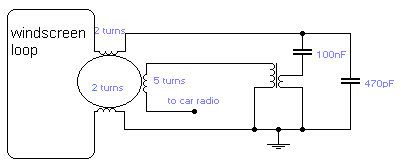
If you do not like the whip antenna on your car, you may try this alternative circuit. A one-turn loop is installed in the windscreen of the car, keeping possibly away from the metal structure of the car. This loop is terminated in a 6.5mm ring core suitable for VHF use. MW and LW are gathered for by the other coil taken from an old MW radio. This is the oscillator coil of the receiver with all capacitors removed and with the slug fully in. Performance depends very much on the components used. In most cases there was no difference compared with a whip antenna although an improvement was found when traveling in tunnels. (View)
View full Circuit Diagram | Comments | Reading(556)
ELECTRONIC I CHING
Published:2013/5/7 21:12:00 Author:muriel | Keyword: ELECTRONIC I CHING
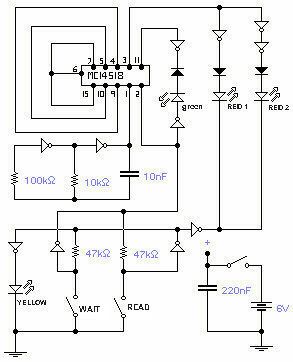
This circuit is the electronic emulation of the I Ching, a form of divination originating in China. In the classical form, the response is obtained by the manipulation of 50 sticks or, more practically, by tossing 3 coins. The process must be repeated 6 times in order to complete what is called an hexagram. The various combinations given by the 6 readings are then read with the help of a book: the I Ching in fact or book of changes, used as a guide for the interpretation of the results. As the hexagrams look very much like a binary code, with additions and subtractions to go from one hexagram to the other, I thought that a hardware implementation could be feasible. The circuit reflects faithfully the chances of the I Ching: it is based on a counter which repeats a certain sequence, like a wheel. You may stop this rotation and read the counter status. In order to operate it you have to power it on and push wait , the yellow LED will be on and all other LEDs will be off. After a short while push read , the yellow LED will go off and the other LEDs will be enabled and the information stored in the double counter will be displayed: either red 1 or red 2 will go on representing a YIN and YANG line respectively. The same line becomes a moving line if also the green LED is lit. This is the first line of the hexagram: repeat the process 6 times by pushing again wait and so on. The whole circuit uses 3 ICs: one double counter and two hex inverters MC14049B. Supply voltage can be anything between 3 and 9V. (View)
View full Circuit Diagram | Comments | Reading(893)
Electronic Fuse for DC Short Circuit Protection
Published:2013/5/7 21:10:00 Author:muriel | Keyword: Electronic Fuse, DC Short, Circuit Protection
View full Circuit Diagram | Comments | Reading(913)
| Pages:42/471 At 204142434445464748495051525354555657585960Under 20 |
Circuit Categories
power supply circuit
Amplifier Circuit
Basic Circuit
LED and Light Circuit
Sensor Circuit
Signal Processing
Electrical Equipment Circuit
Control Circuit
Remote Control Circuit
A/D-D/A Converter Circuit
Audio Circuit
Measuring and Test Circuit
Communication Circuit
Computer-Related Circuit
555 Circuit
Automotive Circuit
Repairing Circuit
